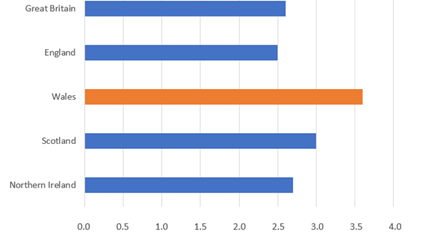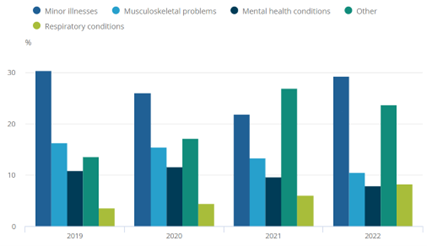Managing Sickness Absence
In this section:
-
What is managing sickness absence?
-
Why is managing sickness absence important?
-
How to manage sickness absence
-
Supporting employees to return to work
-
Monitoring Attendance
-
Resources and further information
-
Key dates
What is managing sickness absence?
Managing sickness absence encompasses how employers monitor, address and support employees who are unable to work due to illness or health-related issues. This includes a range of activities aimed at minimising the impact of absences on employers while ensuring that employees receive appropriate support.
Effective absence management is essential for both the employee and employer:
By understanding and implementing effective sickness absence management practices, employers can create a healthier, more productive and legally compliant workplace.
Most absences taken in the workplace will be short-term absences. A short-term sickness absence is when an employee is unable to attend work because of sickness or ill health for less than four weeks.
A long-term sickness absence is when an employee needs to take more than four weeks’ sickness leave. Supporting staff with long-term conditions is an important aspect of an inclusive and productive workplace. The most common cause of long-term absences in the past year was mental health related illnesses, such as clinical depression and anxiety, followed by more serious physical injuries.
According to a report published in 2023 by Chartered Institute of Personnel and Development (CIPD) and Simplyhealth, minor illnesses (94%), musculoskeletal injuries (45%) and mental health issues (39%) were the top reasons for short-term absenteeism. Long-term absence was primarily driven by mental health problems (63%), acute medical conditions like stroke or cancer (51%), and musculoskeletal injuries (51%).
Why is managing sickness absence important?
Employers should manage sickness absences effectively to prioritise employee wellbeing while maintaining productivity. Supporting employees during their absence creates a healthier and more positive work environment.
Sickness absences can impact on the workforce in a number of ways:
- Decreased employee morale
The absence of valued colleagues lowers morale and creates instability, affecting engagement and motivation.
- Impact on team dynamics
Team cohesion and productivity can suffer due to the adjustment required when a key member is absent.
- Loss of expertise and knowledge
Absences of skilled staff lead to gaps in expertise, affecting work quality and efficiency.
- Disruption of continuity
Long-term absences disrupt projects and processes, causing delays.
- Increased workload for others
Remaining staff may face increased stress due to redistributed responsibilities.
From an employer's perspective, poor absence management can result in:
- Increased financial costs
Finding and training new employees to replace valuable staff can be costly and time-consuming, straining resources and budget.
- Lost output and reduced performance
Absences disrupt workflows and project timelines, leading to lost productivity and reduced work quality and efficiency.
- Reputational risk
High absence rates can harm an employer’s reputation, making talent attraction and retention difficult.
- Complications with cover and workflow arrangements
Covering for absent employees can be complex and disruptive, leading to workflow inefficiencies and increased stress for current employees, ultimately reducing overall productivity and morale.
Absence management should be a high priority issue for Welsh businesses, as data from the Office of National Statistics (ONS) suggests that Wales had the highest absence rate in the UK in 2022, a trend seen in previous years.
Figure 1: Sickness absence rate, by UK country of residence, 2022

The ONS also reports that in Wales:
- The sickness absence rate, which measures the percentage of working hours lost due to sickness or injury, increased to nearly 4% in 2022. This represents a rise of almost one percentage point compared to 2021 and is the highest rate recorded since 2001, when it was also nearly 4%
- An estimated 11.6 million working days were lost because of sickness or injury in 2022
Figure 2: Percentage of occurrences of sickness absence, by top five reasons, UK, 2019 to 2022

Notes:
*'Other' includes accidents, poisonings, infectious diseases, skin disorders, diabetes and anything else not covered.
* Respiratory conditions covers a wide variety of conditions, including common conditions such as asthma and chronic obstructive pulmonary disease (COPD), lung cancer, infections such as pneumonia and flu.
Figure 2, produced by the ONS, displays the percentage of sickness absence occurrences in the UK, categorised by the top five reasons from 2019 to 2022. According to the ONS, during this period:
- Illnesses like colds and flus, stomach upsets, headaches, and migraines continued to be the leading causes of short-term sickness absence.
- Respiratory conditions surpassed mental health conditions to become the fourth most common reason for sickness absence in 2022, accounting for more than twice the proportion of occurrences they did before the pandemic.
How to manage sickness absence
Organisations should have in place a comprehensive sickness absence policy to manage sickness absence effectively. Efforts should be made to ensure it is understood by all employees, and line managers should receive training on how to implement it.
Steps to managing sickness absence might include:
Disability-related absence
A person is disabled under the Equality Act 2010 if they have a physical or mental impairment that has a ‘substantial’ and ‘long-term’ negative effect on their ability to do normal daily activities.
Some employees will need to take absence from work because of reasons related to their disability. This is known as disability leave. For example, their disability might make them feel too sick to attend work on occasion, or they might need time off to attend medical appointments, treatment or therapy. It is vital that you have a separate disability absence policy and do not treat sickness absence and disability related absence in the same way.
To find out how to support disability-related absences, please see our health conditions and impairments webpage.
Promoting health and wellbeing in the workplace
Employers have a role to encourage employees to look after their mental and physical health by promoting healthy lifestyle choices. The CIPD recommends implementing a health and wellbeing strategy to demonstrate the organisation’s commitment to supporting employee health. The strategy could include the following:
- National campaigns and awareness days: utilise these opportunities to share information about specific health topics and show support from senior leadership.
- Support an open culture: encourage a workplace culture that creates open and honest dialogue around mental and physical health.
- Promote flexible working practices: where possible, support flexible working arrangements to accommodate employees' health and wellbeing needs.
To support your employees to remain physically and mentally healthy and to minimise sickness absences, look at our other topic pages on the HWW website.
Supporting Employees to 'Return to Work'
Supporting employees in their return to work is a critical component of maintaining a healthy and productive workplace. It is essential to ensure that employees feel supported, valued and prepared as they transition back into their roles. Here are key elements to consider:
Monitoring Attendance
Implementing an attendance management system allows employers to monitor employee absences at an organisational level, ensuring data is collated anonymously. Establishing clear processes for monitoring and addressing attendance issues, employers can proactively support their workforce and reduce overall absenteeism by.
- Identifying intervention points
Recognise when specific employees or teams may need support or intervention.
- Set absence targets
Use the collected data to establish and achieve targets for reducing absences. These targets should be based on a concerted effort to understand and mitigate the reasons for absences.
Key aspects of the system:
- Data collection
Gather anonymised data on the length and reasons for both short-term and long-term absences.
- Categories of absence
Distinguish between general absences and disability-related absences, treating them as separate categories to ensure clarity.
- Repeat absences
Consider tracking the number of repeat absences to identify patterns and areas needing attention.
Oversight and recommendations:
- Establish an oversight group
Form a dedicated group to oversee the monitoring process, review data and make recommendations for interventions and improvements.
- Employee surveys
Conduct regular employee surveys to gather feedback and input on workplace conditions and potential causes of absences. This can be facilitated through online survey tools to ensure broad participation and anonymity.
Note: Employers must comply with the Data Protection Act 2018 (DPA) when collecting and using data related to employees’ absence.
Key Dates
The following campaigns serve as useful opportunities for workplace activities and awareness-raising, often providing valuable resources for employers to use across their organisation.
|
Months |
Campaign |
|
February |
Time to Talk Day (the UK’s biggest mental health awareness day) |
|
April |
|
|
May |
|
|
June |
|
|
October |
|
|
November |
|
|
|
|
|
December |